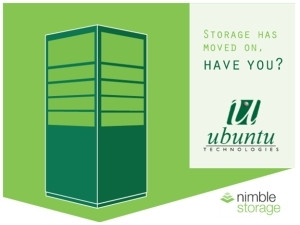
It is not often that this IT dinosaur gets excited over new developments in the storage discipline. Come on, let's face it, things haven't really changed that much over the past 15 years when it comes to storage area networks, or SANs, says Ubuntu Technologies.
Sure there have been improvements and functionality has been added over these years, but there has never really been a fundamentally different way in how the all-important 1s and 0s are handled.
When new technologies did become available, such as solid state drives (SSD), storage vendors rushed to retro-fit their existing solutions to accommodate this new technology, but it seems nobody put proper thought into how best something like SSD could be implemented to address the ever-present issue of capacity versus performance.
There was always this dependency to rely on disk spindles to provide both IO and capacity. It was a necessary evil, the one could not exist without the presence of the other - capacity implied IO and IO implied capacity. Designing these systems to provide both performance and capacity could be a week-long nightmare and take a fair bite out of your budget. Write penalties of the underlying RAID system had to be calculated since their effect on overall IO could have tremendous negative impact on the solution. The capacity-performance scales could never be balanced; it was always one over the other. All-flash arrays addressed the IO challenge, but at the cost of providing extremely expensive capacity, that frankly, very few customers can afford. Again, all flash systems are not the silver bullet that will balance the capacity and performance scales due to their inhibitive cost.
January 2008 ushered in a brand new era in storage area network devices with the founding of a company called Nimble Storage. The founding fathers (with vast storage experience that they gained at companies such as NetApp and Data Domain - to name but a few) of this new product, took SSD and cloud computing into account when their products were designed from the ground up. They shipped their first product in August 2010 and have redefined storage forever. They have truly become the new benchmark in mainstream SAN devices and technologies.
They have managed to break the performance-capacity interdependency that has existed since the first disk drive. They have managed to build a solution that scales to deliver IOs in excess of 500 000 IOPs and 2PB of disk capacity, with current disk drive capacities. But, the real magic is in the way that they have de-coupled the performance requirement from the capacity requirement. Their architecture allows for customers to individually scale performance (without adding disk drives) and capacity. Their solution also allows a customer to scale-out by clustering individual devices together as a single logical unit.
In storage solution designs that Ubuntu Technologies has completed for its customers, it has seen the following benefits being introduced into their environments:
* Replaced 208 disk drives (mixture of SSD, SAS and NL-SAS with fewer than 30 drives
* Reduced the storage rack footprint from 29U down to 6U
* Delivered 17% more IOPS in the 6U footprint than what the tiered 29U solution provided
* The power consumption was significantly less in the 6U footprint
* The power cables required were reduced from 30 down to four
* The rack weight was reduced from 400kg down to 70kg
* The overall solution cost 60% less than the traditional tiered storage solution
The above is from a real-life example of a South African customer, but it is not as extreme as some of the other customers that we have heard from:
* Customer in Africa replaced 2 x 42U racks filled with traditional storage with a 6U storage solution
* The new solution finished a process that used to take five days on the traditional storage, in two hours
So, how does all of this work?
The devices do use SSD drives, but purely for cache read acceleration, not to deliver write IO benefits. Data optimisation and compression algorithms run in real-time and has zero impact on published performance metrics. Variable block sized data is accepted at the front end via either iSCSI or fibre channel ports, compressed in real-time and an algorithm determines whether the data is deemed "hot" or not. These compressed variable blocks are then written (coalesced) to VNRAM into a contiguous stripe. Data is mirrored to the second controller and a write acknowledge is sent back to the server in the order of about 250s. Once the stripe is full, the hot data is written to SSD which provides a large read cache area and also committed to the NL-SAS drives for long-term storage.
Additional storage shelves can be added to the array to expand the capacity requirements. These shelves support NL-SAS drive technologies and provide triple parity protection - remember that write acknowledgements are sent when data is copied to second controller, not when they are written to NL-SAS drives. NVRAM is protected by large capacitors and a dual controller architecture is in place as well.
Nimble also provides a pro-active support platform that is best of breed. Remember I mentioned that they designed these beasts when cloud technologies were available and being used. Well, they have built a brilliant management platform that is hosted in the cloud and provides customer to vital information and support infrastructure. Nimble currently has in excess of 12 000 global deployments. Each one of these arrays send performance metrics and sensor data to this Infosight cloud-based platform every five minutes and on-demand. They collect between 12 million and 70 million bits of sensor data per array, per day! You will never be asked to upload the last logs of your array, they always have the latest available telemetry on hand.
This tool also provides Ubuntu's customers with the ability to not just do system administrator functions, but in-depth "What-if" scenarios, correlations and trending with projections. Data visualisation, capacity planning and performance management becomes a breeze.
With 24x7 local support and support and integration with all the major software vendors, operating this baby is simply....amazing!
Even Gartner is excited about this company - they are adding new, unique customers at a rate of more than 530 per quarter.
So in closing, yes, for the first time in over 15 years of storage design, I am excited about storage once again. That old twinkle in my eye is back, and the reflux is much better as well.
For more info contact us on info@ubuntusa.co.za.
Share
